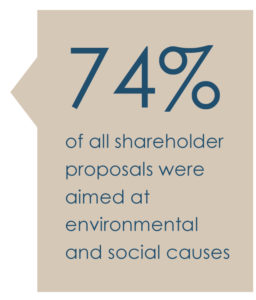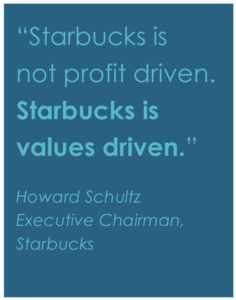March 2018
Preparing for the Year of the “S”

Social Issues Driving ESG Movement
By Michael Flaherty and Josh Clarkson
Guns, addiction, discrimination.
While classic shareholder activists remain a front-burner concern for corporate America, companies are also grappling with a wave of environmental, social and governance (ESG) policy pressures. Within that struggle, the “S” factor is under the microscope.
So far this year, 74 percent of all shareholder proposals were aimed at environmental and social causes, a percentage nearly double that from five years ago, according to ISS Analytics, the data arm of Institutional Shareholder Services Inc.
Within that “E&S” category, social concerns are increasingly on the minds of investors and employees, in a trend that gained momentum last year. Proxy Insight data show that social-related proposals spiked 25% in 2017 to become the most common variety of shareholder proposals submitted, taking the mantle from proxy access. “S” types of proposals last year focused on issues including board diversity, gender pay gaps and discrimination, to name a few. This year, investors are putting pressure on gunmakers and pharmaceutical companies.
Social Investors at the Gate
The pressure is coming not just from pension funds, individual and socially minded shareholders. Index funds, proxy advisors, the U.S. government and activist investors are all playing a role.
In January, BlackRock CEO Larry Fink publicly urged companies to serve a social purpose in his annual letter. The asset manager’s updated guidelines on proxy voting now expect boards to have at least two female directors. State Street Global Advisors said it will abstain from voting on certain pay packages. On the asset owner side, the Council of Institutional Investors is recommending companies take steps to reduce the risk of sexual harassment, including pay clawbacks, disclosure of all settlements to the Board and revising corporate policies.

ISS launched a new Environmental & Social QualityScore product for its clients, which will cover 5,500 companies across the globe by the second quarter. This rubric will apply their approach to corporate governance to the “E” and the “S” as well, and grade companies against peers on everything from ethical sourcing, to animal welfare, to product safety. One subcategory includes measuring whether compensation is linked to ESG metrics. While there are many different metrics and many vendors selling their best index, what matters is the substance of a company’s efforts.
The government’s hand in the “S” argument also comes into play this proxy season, as the SEC pay ratio rule goes into effect. The rule requires the disclosure of the ratio of a CEO’s compensation to the median compensation of its employees – the wider the ratio, the more angst anticipated from employees and investors.
Meanwhile, activist hedge funds are digging deeper into their portfolio companies’ impact on society - Blue Harbour, Jana Partners and Trian Partners to name a few. ValueAct Capital is deploying $100 million to invest in companies addressing environmental and societal problems.
Whether activists view these efforts as engines for shareholder returns or wedges to push their influence remains to be seen. Social factors’ impact on returns is also to be determined, putting CEOs in a bind: prioritize long-term goals for the good of the company and broader society while risking short-term gains and their jobs in the process.
While that debate simmers, investors show they’re buying into the ESG trend. A Harvard Business School study found that 82% of investors surveyed consider ESG information, most often because they find it material to investment performance. In another sign of a heightened “S” focus, a CFA Institute survey showed a 10% increase in the number of portfolio managers and research analysts who take social issues into account when making investment decisions.
Define Your Social Purpose—Employees and Others Demand It
How should companies respond to this relatively new wave of investor demand? Write a letter back to Larry Fink. Articulate your long-term plan and social impact to investors before someone else does it for you.
Such a narrative requires substantive steps to address these issues. Intel rolling out technical training and education to underrepresented youth groups. Medtronic using telemedicine to expand access for diagnosing and treating heart attack patients.
Executing on this IR and communications objective involves a multifaceted approach. Companies’ ability to get on the front foot regarding key social issues helps ensure that they’re not on their heels with investors, while providing a mission for employees and being part of the solution in the communities they serve.
“Starbucks is not profit driven. Starbucks is values driven, and as a result of those values, we have become very profitable. Not every business decision should be an economic one,” Starbucks Executive Chairman Howard Schultz said during a recent “Masters of Scale” podcast interview with Reid Hoffman. “…We're not perfect, we make mistakes, but our financial performance is directly linked to the enduring values and culture that we are constantly trying to enhance and preserve.”
Michael Flaherty is a senior vice president at Gladstone Place Partners.
Josh Clarkson is a vice president at Gladstone Place Partners.